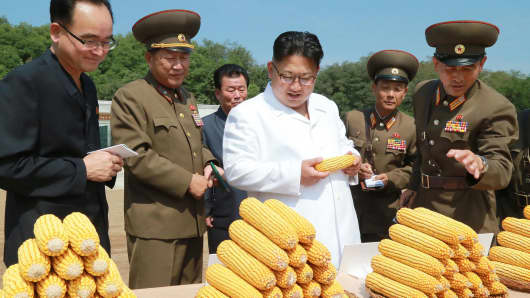Some Answers On Clear-cut Strategies

 Also, less than 20 percent of North Korea is suitable for agriculture since most of the country is mountainous terrain. Still, the situation is better than the 1990s when a severe famine claimed as many as 2.4 million lives. Domestic production of staple crops such as rice and corn has grown although the country of just over 25 million people still remains dependent on food aid primarily from China . "Production has been increasing over the last five years because of changes in agriculture," said Linda Lewis, country director for DPRK at American Friends Service Committee, a Philadelphia-based Quaker organization that has worked with and in North Korea on agricultural and economic issues for several decades. DPRK is short for North Korea's formal name, the Democratic People's Republic of Korea. North Korea's agriculture is centrally managed and based mostly on cooperative farms while a smaller portion are state industrial farms operated as government enterprises. The average farm in the country has nearly 3,000 people and gets its marching orders of what will be grown usually from the government. Even so, Lewis said there have been reforms by North Korea in the past several years that have allowed farmers "more local discretion and individual control over decisions on allocated pieces of land." The government also allows farmers to sell or barter food when there's a surplus beyond certain production targets. At the same time, changes in the management of agriculture by the government in the last five years have produced what Lewis calls "more resilience in the face of droughts." Zhang Jin | American Friends Service Committee Rice field in North Korea where the use of plastic trays for cultivating rice seedlings has improved production.
Also, less than 20 percent of North Korea is suitable for agriculture since most of the country is mountainous terrain. Still, the situation is better than the 1990s when a severe famine claimed as many as 2.4 million lives. Domestic production of staple crops such as rice and corn has grown although the country of just over 25 million people still remains dependent on food aid primarily from China . "Production has been increasing over the last five years because of changes in agriculture," said Linda Lewis, country director for DPRK at American Friends Service Committee, a Philadelphia-based Quaker organization that has worked with and in North Korea on agricultural and economic issues for several decades. DPRK is short for North Korea's formal name, the Democratic People's Republic of Korea. North Korea's agriculture is centrally managed and based mostly on cooperative farms while a smaller portion are state industrial farms operated as government enterprises. The average farm in the country has nearly 3,000 people and gets its marching orders of what will be grown usually from the government. Even so, Lewis said there have been reforms by North Korea in the past several years that have allowed farmers "more local discretion and individual control over decisions on allocated pieces of land." The government also allows farmers to sell or barter food when there's a surplus beyond certain production targets. At the same time, changes in the management of agriculture by the government in the last five years have produced what Lewis calls "more resilience in the face of droughts." Zhang Jin | American Friends Service Committee Rice field in North Korea where the use of plastic trays for cultivating rice seedlings has improved production.
For the original version including any supplementary images or video, visit https://www.cnbc.com/2018/06/21/long-before-the-trump-kim-summit-us-based-group-sowed-seeds-of-peace.html
![[ทัวร์ญี่ปุ่น]](https://png.pngtree.com/element_pic/17/03/18/eec06edbfac44a28daa201d0057db361.jpg)
![[ทัวร์เกาหลี]](http://danimtravel.com/wp-content/uploads/2017/05/waveon_04.jpg)
A Simple Overview Of Swift Plans In

 Some want to learn about South Korea’s historical cultural links with their own country and the source of Korean drama that’s a rage on Chinese television. It’s too early to say for sure that Chinese will restart trips, and any increase would take time to rebuild. But signs are emerging. “It will take six months before group tourism will rebound because of time needed to organize and market tours,” says Charles Morrison, a senior scholar with the East-West Center think tank in Honolulu. “Individual tourism from China, however, is beginning to recover already, although it also takes time to plan vacations.” In December travel agencies in Beijing and the Chinese province of Shandong started selling Korea tour packages, Yonhap news agency reported. More on Forbes: Why North Korea's Strongman Kim Jong-un Is Emerging From Isolation The two sides’ foreign ministries agreed in October to normalize relations , and Korean President Moon Jae-in's upbeat state visit to China in December further eased the bad mood of a year ago. But China won’t push its travel agencies, many of them state-run, too fast in case South Korea and its neighbors imagine the boycotts don’t work, says Leif-Eric Easley, associate professor of international studies at Ewha University in Seoul. “China is likely slow-rolling the removal of anti-THAAD measures in an attempt to make future economic threats credible to South Korea, Taiwan, Japan and ASEAN countries,” Easley says. “Maintaining the fiction that boycotts against South Korea are grassroots behavior is meant to give Beijing plausible deniability for possible trade rule violations.” As Chinese started avoiding South Korea, their arrivals fell 61% from March to October for a total of 2.38 million compared to the same period a year earlier, Korean Tourism Organization statistics show. In January this year, 305,127 Chinese visitors reached South Korea, a decline of 46% from the same month of 2017. Tourism statistics for February 2018, a major travel season for China due to its extended Lunar New Year holiday, haven’t come out.
Some want to learn about South Korea’s historical cultural links with their own country and the source of Korean drama that’s a rage on Chinese television. It’s too early to say for sure that Chinese will restart trips, and any increase would take time to rebuild. But signs are emerging. “It will take six months before group tourism will rebound because of time needed to organize and market tours,” says Charles Morrison, a senior scholar with the East-West Center think tank in Honolulu. “Individual tourism from China, however, is beginning to recover already, although it also takes time to plan vacations.” In December travel agencies in Beijing and the Chinese province of Shandong started selling Korea tour packages, Yonhap news agency reported. More on Forbes: Why North Korea's Strongman Kim Jong-un Is Emerging From Isolation The two sides’ foreign ministries agreed in October to normalize relations , and Korean President Moon Jae-in's upbeat state visit to China in December further eased the bad mood of a year ago. But China won’t push its travel agencies, many of them state-run, too fast in case South Korea and its neighbors imagine the boycotts don’t work, says Leif-Eric Easley, associate professor of international studies at Ewha University in Seoul. “China is likely slow-rolling the removal of anti-THAAD measures in an attempt to make future economic threats credible to South Korea, Taiwan, Japan and ASEAN countries,” Easley says. “Maintaining the fiction that boycotts against South Korea are grassroots behavior is meant to give Beijing plausible deniability for possible trade rule violations.” As Chinese started avoiding South Korea, their arrivals fell 61% from March to October for a total of 2.38 million compared to the same period a year earlier, Korean Tourism Organization statistics show. In January this year, 305,127 Chinese visitors reached South Korea, a decline of 46% from the same month of 2017. Tourism statistics for February 2018, a major travel season for China due to its extended Lunar New Year holiday, haven’t come out.
For the original version including any supplementary images or video, visit https://www.forbes.com/sites/ralphjennings/2018/03/04/china-keeps-punishing-south-korea-with-tourism-cuts-for-now/
ทัวร์ เกาหลี 2 คืน ทัวร์ญี่ปุ่น ระดับพรีเมี่ยม ทัวร์ญี่ปุ่น 62
No comments:
Post a Comment